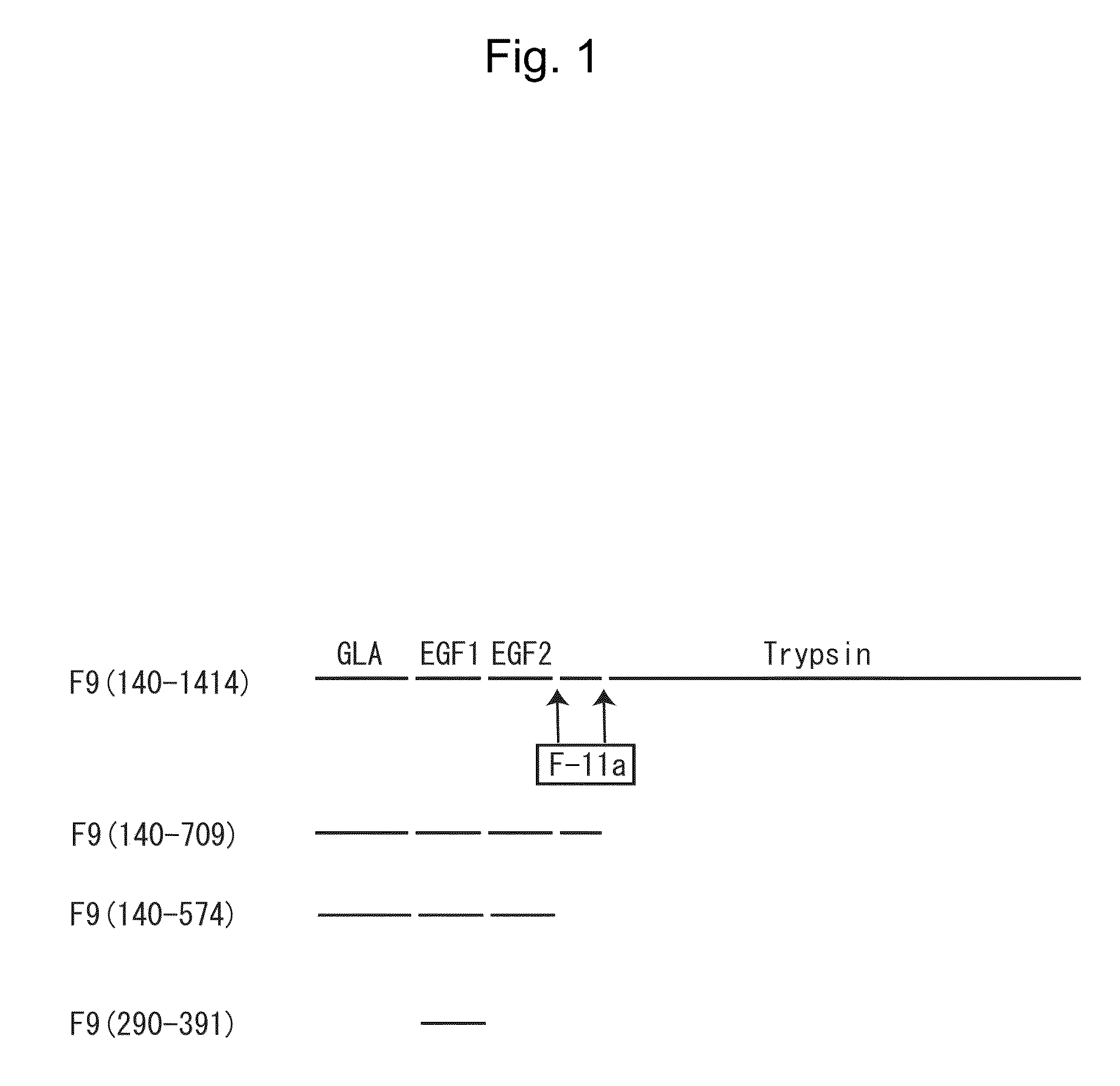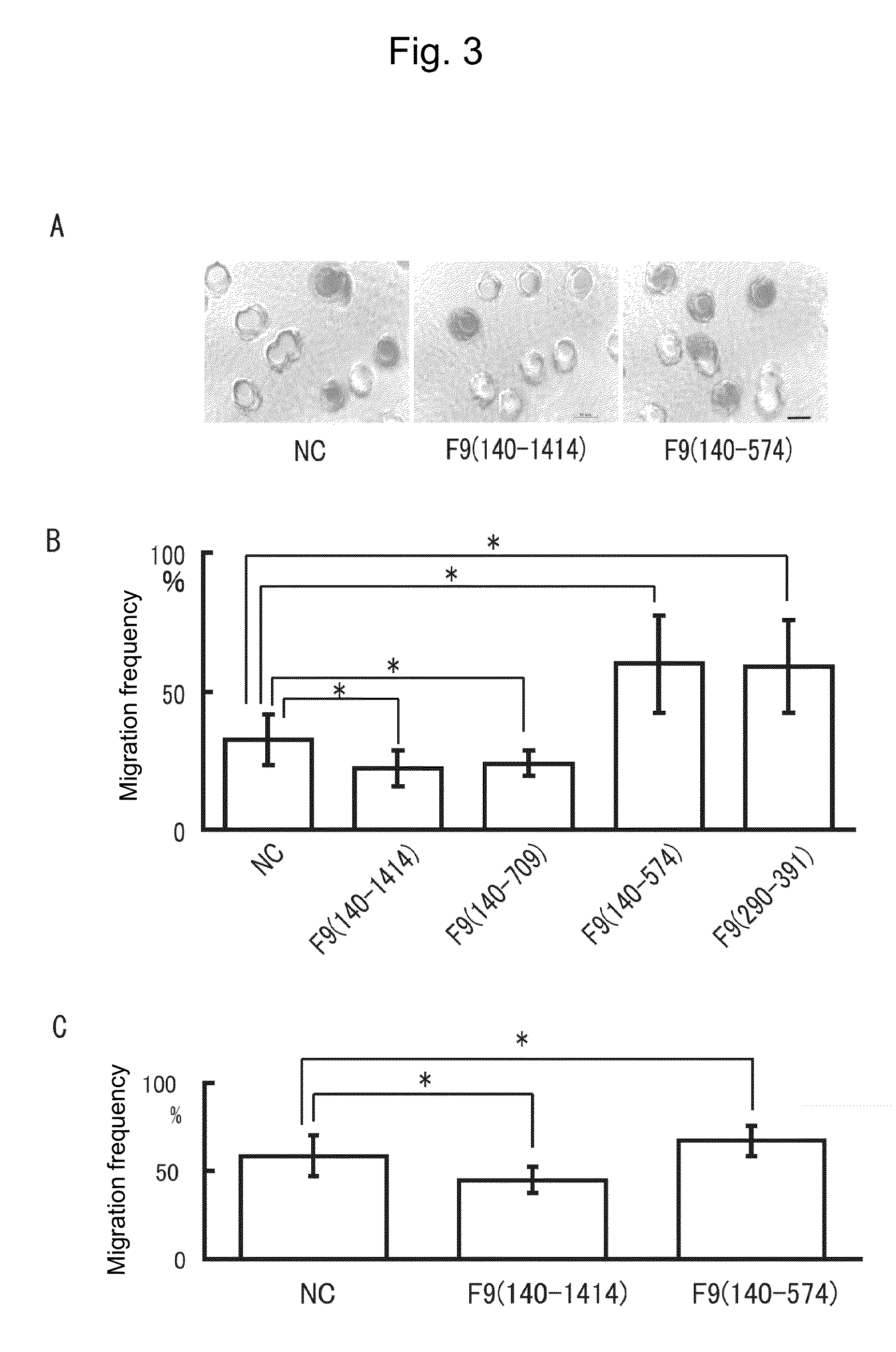Cell migration regulator
a cell migration and regulator technology, applied in the field of cell migration regulators, can solve the problems of insufficient degree of promotion, inability to further develop, and difficult formulation of full-length del-1, so as to promote cell migration, promote cell migration, and maintain the epithelial morphology of cells
- Summary
- Abstract
- Description
- Claims
- Application Information
AI Technical Summary
Benefits of technology
Problems solved by technology
Method used
Image
Examples
reference example 1
Structure of Blood Coagulation Factor IX Protein
[0124]As shown in FIG. 1, the amino acid sequence (SEQ ID NO: 2) constituting the full-length blood coagulation factor IX (F9) (F9(140-1414) in the figure) comprises, from the N-terminal side, the GLA domain and the downstream two EGF domains (EGF1, EGF2), on the C-terminal side of which the trypsin domain is linked via an amino acid sequence region composed of about 45 residues. During the progress of coagulation reaction, the amino acid sequence is cleaved at the sites indicated with arrows in FIG. 1 by the action of activated blood coagulation factor XI (F-11a in the figure) (to thereby remove the above amino acid sequence region composed of about 45 residues). The fragment N-terminal to the amino acid sequence region removed by cleavage is the light chain of F9, while the fragment C-terminal to the region is the heavy chain of F9 (i.e., the trypsin domain).
example 1
[0125]A plastic ring was placed in a 3 cm culture dish, and SCCKN cells (oral squamous cell carcinoma cell line) were seeded within the plastic ring and cultured for 24 hours. The ring was removed and the cells were imaged at one minute intervals. After observation for 6 hours in a normal culture solution, the culture solution was supplemented with alkaline phosphatase (AP; negative control) or a recombinant protein, i.e., AP-F9(140-1414), AP-F9(140-709), AP-F9(140-574) or AP-F9(290-391) (which is simply expressed as F9(140-1414), etc., in FIG. 2) at a concentration of 0.1 pmol / ml, followed by further observation. These recombinant proteins are fusion proteins between AP and the full-length F9 or a part thereof, each of which was prepared by constructing a recombinant vector where cDNA encoding a desired peptide (the full-length F9 or a part thereof) was inserted into an alkaline phosphatase (AP) expression vector (APtag4) to give a fusion gene with the AP gene by...
example 2
Boyden Chamber Assay
[0126]To evaluate cell migration ability by another assay different from the Wound healing assay used in Example 1, Boyden chamber assay was conducted with a Chemotaxicell (Kurabo Industries, Ltd., Japan). The recombinant proteins and negative control used in this assay, as well as their amounts added were the same as those in Example 1. The upper layer was charged with an excessive amount of cells (SCCKN cells or Cos cells) floating in a serum-free culture solution, while the lower layer was charged with a serum-containing normal culture solution, followed by culture for 30 minutes to 1 hour. After being fixed with 4% paraformaldehyde, the cells were stained with trypan blue and observed under a microscope to determine the ratio of pores holding the cells. The results obtained are shown in FIG. 3. It should be noted that the scale bar in the photographs of FIG. 3A represents 10 μm.
PUM
| Property | Measurement | Unit |
|---|---|---|
| concentration | aaaaa | aaaaa |
| concentration | aaaaa | aaaaa |
| concentration | aaaaa | aaaaa |
Abstract
Description
Claims
Application Information
 Login to View More
Login to View More - R&D
- Intellectual Property
- Life Sciences
- Materials
- Tech Scout
- Unparalleled Data Quality
- Higher Quality Content
- 60% Fewer Hallucinations
Browse by: Latest US Patents, China's latest patents, Technical Efficacy Thesaurus, Application Domain, Technology Topic, Popular Technical Reports.
© 2025 PatSnap. All rights reserved.Legal|Privacy policy|Modern Slavery Act Transparency Statement|Sitemap|About US| Contact US: help@patsnap.com



